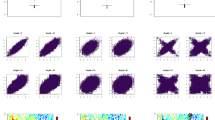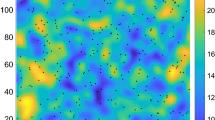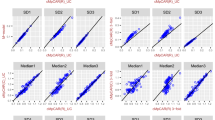Abstract
A space-time, univariate dataset is assumed to have been sampled from a 3-dimensional Markov Random Field where the data dependence structure is modeled through pairwise interaction parameters. The likelihood function depends upon (1) an undirected, 3-dimensional graph, where edges connect observation points, and (2) the parameter dimension that captures possible space-time anisotropy of data interaction. Automatic model selection to discriminate both the graph and the model dimension is suggested on the basis of a penalized Pseudo-likelihood function. In most cases, the procedure can be implemented using standard statistical packages capable of GLM estimation. Weak consistency of the criterion is shown to hold under mild and easily verifiable sufficient conditions. Its performance in small samples is studied providing simulation results.
Similar content being viewed by others
References
Akaike H (1969) Fitting Autoregressive models for prediction. Annals of the Institute of Mathematical Statistics21, 243–247
Barnett S (1990) Matrices: methods and applications. New York: Oxford University Press
Besag JN (1974) Spatial interactions and the statistical analysis of lattice data. Journal of the Royal Statistical Society B36, 192–225
Besag JN, York J, Mollié A (1991) Bayesian image restoration, with two applications in spatial statistics. Annals of the Institute of Statistical Mathematics43, 1–59
Burnham KP, Anderson DR (1998) Model selection and inference. New York: Springer Verlag
Chiristakos G (1992) Random field models in earth sciences. New York: Academic Press
Cressie N (1993) Statistics for spatial data (revised edition). New York: Wiley
Dobrushin RL (1968) The description of a random field by mean of conditional probabilities and conditions of its regularity. Theory of Probability and its Applications13, 197–224
Geman D, Geman S (1984) Stochastic relaxation, Gibbs distributions and the Bayesian restoration of images. IEEE PAMI6, 721–741
Geyer CJ, Thompson EA (1992) Constrained Monte Carlo maximum likelihood for dependent data. Journal of the Royal Statistical Society B54, 657–699
Griffith DA, Lagona F (1988) On the quality of likelihood-based estimators in spatial autoregressive models when the data dependence structure is misspecified. Journal of Statistical Planning and Inference69, 153–174
Gumpertz ML, Graham JM, Ristaino JB (1997) Autologistic model of spatial patterns of phytophtora epidemic in bell pepper: effect of soil variables on disease presence. Journal of Agricultural, Biological and Environmental Statistics2(2), 131–156
Guyon X (1995) Random fields on a network. New York: Springer-Verlag
Guyon X, Yao JF (1999) On the underfitting and overfitting sets of models chosen by order selection criteria. Journal of Multivariate Analysis70, 221–249
Hoeffding W (1963) Probability inequality for sums of bounded random variables. Journal of the American Statistical Association58, 12–30
Huffer FW, Wu H (1998) Markov chain Monte Carlo for autologistic regression models with application to the distribution of plant species. Biometrics54, 509–524
Hughes JP, Guttorp P, Charles SP (1999) A non-homogeneous hidden Markov model for precipitation occurrence. Applied Statistics48, 15–30
Ji C, Seymour L (1998) A consistent model selection procedure for Markov random fields based on penalized likelihood. Annals of Applied Probability6, 423–443
Jona Lasinio G (2001) Modeling and exploring spatial variation. Journal of Multivariate Analysis77, 295–317
Kashyap R, Chellappa R (1983) Estimation and choice of neighbours in spatial interaction models of images. IEEE Transactions on Information Theory29, 60–72
Knorr-Held L, Besag J (1998) Modelling risk in time and space. Statistics in Medicine17, 2045–2060
Lagona F (2002) Adjacency selection in Markov random fields for high resolution, hyperspectral data. Journal of Geographical Systems-Special Issue on High Spatial Resolution Hyperspectral Imagery4(1), 53–68
McCullagh PA, Nelder JA (1989) Generalized linear models 2nd edn. London: Chapman and Hall
Onsanger L (1944) Cristal statistics I: a two-dimensional model with order-disorder transition. Phisical Review65, 117–149
Petrov VV (1995) Limit theorems in probability theory. Oxford: Clarendon Press
Pickard DK (1987) Inference for discrete Markov fields: the simplest nontrivial case. Journal of the American Statistical Association82, 90–96
Schwartz G (1978) Estimating the dimension of a model. Annals of Statistics6, 461–464
Taxt T, Lundervold A, Angelsen B (1990) Noise Reduction and segmentation in time-varying ultrasound images. In: The Tenth International Conference on Pattern Recognition Atlanta City NJ, pp 591–596
Tonellato SF (2001) A multivariate time series model for the analysis and prediction of carbon monoxide atmospheric concentrations. Applied Statistics50, 187–200
Waller LA, Carlin BP, Xia H, Gelfand A (1997) Hierarchical spatio-temporal mapping of disease rates. Journal of the American Statistical Association92, 607–617
Author information
Authors and Affiliations
Rights and permissions
About this article
Cite this article
Lasinio, G.J., Lagona, F. Selection of the neighborhood structure for space-time Markov random field models. Statistical Methods & Applications 11, 293–311 (2002). https://doi.org/10.1007/BF02509829
Issue Date:
DOI: https://doi.org/10.1007/BF02509829




